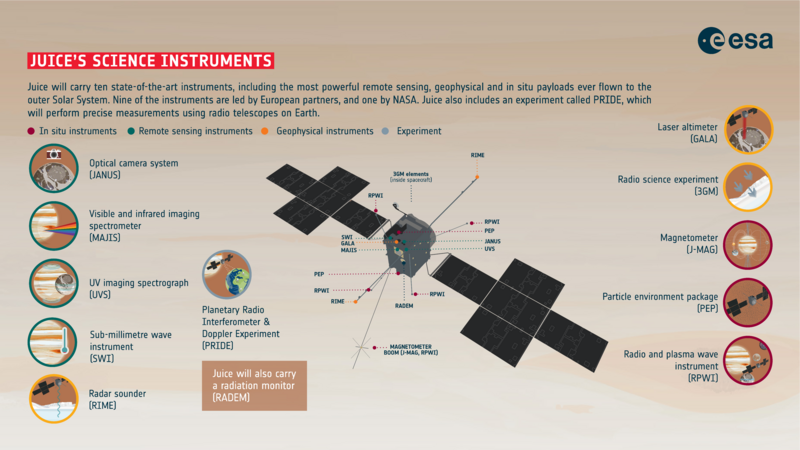Image: Juice’s science instruments ESA24640659

Description: ESA’s Jupiter Icy Moons Explorer (Juice) will carry the most powerful remote sensing, geophysical, and in situ payload complement ever flown to the outer Solar System. It includes 10 dedicated scientific instruments, a radiation monitor (RADEM) and the Planetary Radio Interferometer & Doppler Experiment (PRIDE).3GM, or the Gravity & Geophysics of Jupiter and Galilean Moons, is a radio package comprising the KaT (Ka transponder), USO (ultrastable oscillator) and HAA (High Accuracy Accelerometer). The experiment will study the gravity field at Ganymede, the extent of the internal oceans on the icy moons, and the structure of the neutral atmosphere and ionosphere of Jupiter and its moons.GALA, the Ganymede Laser Altimeter will study the tidal deformation of Ganymede and the topography of the surfaces of the icy moons.JANUS, an optical camera system, will study global, regional and local features and processes on the moon, as well as map the clouds of Jupiter. It will have a resolution up to 2.4 m on Ganymede and about 10 km at Jupiter.J-MAG is the Juice magnetometer; it is equipped with sensors to characterise the Jovian magnetic field and its interaction with that of Ganymede, and to study the subsurface oceans of the icy moons.MAJIS is the Moons and Jupiter Imaging Spectrometer. It will observe cloud features and atmospheric constituents on Jupiter, and will characterise ices and minerals on the icy moon surfaces.PEP is the Particle Environment Package. It comprises a package of sensors to characterise the plasma environment of the Jupiter system and the icy moons.RIME, the Radar for Icy Moons Exploration, is an ice-penetrating radar to study the subsurface structure of the icy moons down to a depth of around nine kilometres.RPWI, the Radio and Plasma Wave Investigation, will characterise the radio emission and plasma environment of Jupiter and its icy moons using a suite of sensors and probes.SWI, the Sub-millimeter Wave Instrument, will investigate the temperature structure, composition and dynamics of Jupiter’s atmosphere, and the exospheres and surfaces of the icy moons.UVS is a UV imaging spectrograph to characterise the composition and dynamics of the exospheres of the icy moons, to study the Jovian aurorae, and to investigate the composition and structure of the planet’s upper atmosphere.RADEM is a radiation monitor that will track how much radiation Juice is exposed to, whilst also being used for science.PRIDE will use Juice’s standard telecommunication system, together with radio telescopes on Earth to perform precise measurements of the spacecraft’s position and velocity to investigate the gravity fields of Jupiter and the icy moons.More about Juice’s science instrumentsJuice will make detailed observations of Jupiter and its three large ocean-bearing moons – Ganymede, Callisto and Europa – with a suite of instruments. The mission will characterise these moons as both planetary objects and possible habitats, explore Jupiter’s complex environment in depth, and study the wider Jupiter system as an archetype for gas giants across the Universe.
Author: European Space Agency
Usage Terms: Creative Commons Attribution-Share Alike 3.0
License: CC-BY-SA-3.0
License Link: http://creativecommons.org/licenses/by-sa/3.0/
Attribution Required?: Yes
Image usage
The following page links to this image:

